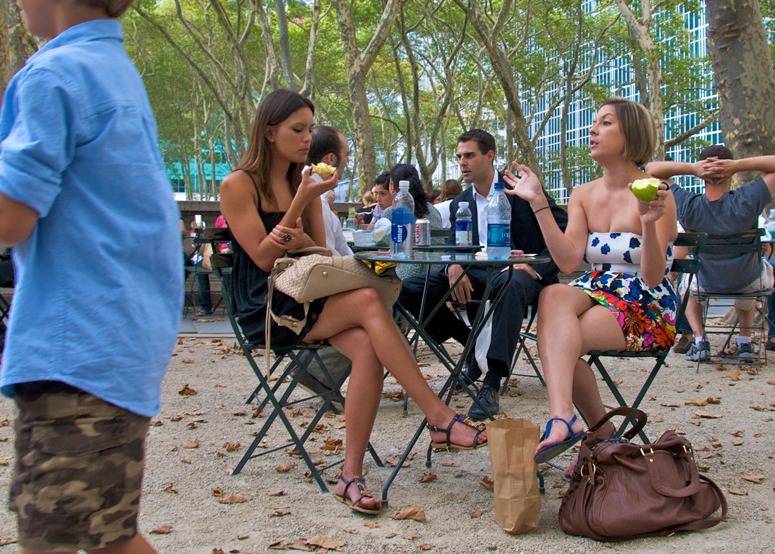Image courtesy bankbryan

Image courtesy Sigfrid Lundberg
Image courtesy bankbryan

Image courtesy Sigfrid Lundberg

Brilliant landscape planning, and dreary landscape architecture, for the Cheonggyecheon River in Seoul, Korea
Korea has implemented a brilliantly ambitious and life-enhancing river restoration project which, unfortunately, is no masterpiece for Korean landscape architecture or garden design. Seoul, formerly Hanyang became Korea’s capital city in 1394 and a new city was built beside the lovely Cheonggyecheon River. Floods arrived from time to time but King Taejong (1400-1418) believed that nature should be allowed to run its course. A great stone bridge was built and the valley became a resort, a laundry, a children’s playground, a place for lantern festivals – and a sewer. During the Japanese occupation (1910-1945) the river was ‘improved’ in the sense of being dredged to protect the occupier’s property. Korean engineers decided the river should be buried and by 1967 it had disappeared from view. Construction of the Cheonggye Elevated Highway began in 1967 and was completed in 1976. It was built above the buried river. An elevated highway was then built above the valley It took 20 years to complete the project. The highway, 50-80m wide and 6km long, was opened in 1984. So far – so awful. But for the great good fortune of the Seoul’s citizens, the engineers were lousey and the steel beams began to rot. A report from the Korean Society of Civil Engineering, in 1992, recommended repairs. The programme of repairs went on for a decade but was innefective.
It was for this reason that the Cheonggyecheon Restoration Project was formulated. Engineers promised to transform Seoul’s grey concrete image. Their professed goal was “a lush, green city where clear waters flow. Through this and other such projects, Seoul will be re-born as a human-oriented environmental city, greatly increasing Seoul’s ‘brand’ value.” Tragically, the project was run by engineers and architects, with some planting, fountains, exterior lighting and ‘works of art’ stuffed in at the last minute. The result can be classed as brilliant landscape planning with crap landscape architecture. It is a terrible wind corridor and looks like the defensive ditch outside a walled Chinese city. Next time, they should make landscape architects the project co-ordinators.
I wish the UK had a river restoration project which was half as good as the Cheonggyecheon project – restoration of the River Fleet would be a good start. But the Koreans do seem to have learned something from the UK. Just as the Dunkirk disaster of June 1940 was proclaimed a victory, so the Cheonggyecheon disaster (photo below) is being presented as a triumph. Both boasts did some good and Seol has been nominated as the World Design Capital for 2010, partly on account of the Cheonggyecheon river reclamation. Still, I don’t think they read my chapter on River engineering, channelization and floods
The placing of benches and trees seems to bring out the worst in public authorities. Having created good SLOAP (= Space Left Over After Planning) they try to ameliorate the problem by calling up the landscapers and asking them to stick in a few benches and trees. Damn them! The correct policy is to treat urban trees not as ‘ornaments’ but as part of a multi-objective urban forestry programme. The objectives could and should include:
– improving the microclimate (eg by providing shelter and shade)
– improving views
– creating spatial containment
– helping to combat global warming
– producing fruit
– creating habitats for wildlife and increasing biodiversity
– producing firewood for local residents (eg from coppice trees)
– managing surface water (SUDS LID)
The below photograph shows Bryant Park in New York City. It was re-designed in the 1980s using ideas drawn from the greatest landscape planning theorist of the twentieth century: William H Whyte. The photographs shows urban seats which are NOT fixed in position, paving which is NOT sealed and trees which deserve the accolade ‘urban forestry’.

Top image courtesy RP Norris Lower image courtesy Ed Yourdon

Designing a city is a complex business. There are commercial and development pressures to be considered. But a city is more
than just a continual investment of capital and occupation of new space. It has an identity. Sometimes only a local one. But sometimes
a global one.
What gives a city its identity? Consider how much of your city can you change and still have your city recognised for the qualities that others
currently value. Ask yourself what attributes are different to other cities and what are the same.
Is going higher the best option? How should it be done? Why should it be done? And when should it be done?
If the skyline was to change which buildings would you miss?
Why?
Looking at London from the Eye gives a whole new perspective on the city. Another view from the Eye enables the viewer to ask ‘how green is my city?’ Some of the answers might surprise.
The French farmer’s protested their financial plight in a charmingly French manner by greening the Champ-Elysee.
Another unusual example of the trend towards green is the Lost House of Paris. The occupants literally live within a greenery covered house. To travel green in the city of romance you simply phone a ‘Vectrix’ taxi.
As Pierre Patel’s 1688 painting of Versailles (below) shows, axes can be green and they can be canals. And canals can be used for transport. Civic leaders need courage, imagination, wisdom – and a wealth of ideas from the design professions.